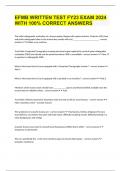EFMB WRITTEN TEST FY23 EXAM 2024 WITH 100% CORRECT ANSWERS
The initial radiographic evaluation of a trauma patient begins with supine Anterior- Posterior (AP) chest and pelvis radiographs taken in the trauma bay usually with a(n) _______________________ - correct answer✔✔ Portable x-ray machine.
True/False: Computed Tomography scanning has been largely replaced by cervical spine radiographic evaluation (CSRE) and should only be performed when CSRE is unavailable - correct answer ✔✔ False, CT
is superior to radiographic CSRE
What is the lowest level of care equipped with a Computed Tomography scanner? - correct answer ✔✔ Role 3
What is the lowest level of care equipped with a portable x-ray machine? - correct answer ✔✔ Role 2
Members of the trauma team should have ___________ aprons and thyroid shields available near the trauma bay for radiation safety. - correct answer ✔✔ lead
True/False: Patients exposed to hazardous noise are only at risk for aural trauma. - correct answer ✔✔ False, hazardous noise = acoustic trauma
The symptoms of acoustic trauma are - correct answer ✔✔ Hearing loss, tinnitus (ringing in the ear), aural fullness, recruitment (ear pain with loud noise), difficulty localizing sounds, difficulty hearing in a noisy background, and vertigo
Acoustic trauma may result in sensorineural hearing loss (SNHL) that is either - correct answer ✔✔ temporary or permanent
The ear, specifically the , is the most sensitive organ to primary blast injury. - correct answer ✔✔ tympanic membrane True/False: The smaller the size of the tympanic membrane perforation, the greater the likelihood is of spontaneous closure. - correct answer ✔✔ True
What are indications for endotracheal intubation during your initial burn survey? - correct answer ✔✔ >40% TBSA due to swelling, comatose, symptomatic inhalation injury, deep facial burns
Burn casualties with injuries greater than _____ Total Body Surface Area (TBSA) are at high risk of hypothermia - correct answer ✔✔ 20%
True/False: When providing point of injury care to a burn patient, you must immediately debride blisters
and cover burns with loose, moist gauze wraps or a wet clean sheet - correct answer ✔✔ False, Do not debride blisters until the patient has reached a facility with surgical capability
Calculate a burn patient's initial burn size using the Rule of - correct answer ✔✔ 9s, head, arms = 9%, 9%, 9%
Torso = 36%
Legs = 18%, 18%
Which type of burn is NOT included in the estimation of Total Body Surface Area (TBSA) used for fluid resuscitation? - correct answer ✔✔ First degree or superficial burns
True/False: In addition to providing immediate care to preserve life, limb, or eye sight when veterinary personnel are not available, human healthcare providers are also responsible for providing routine medical, dental, or surgical care to Military Working Dogs in combat or austere areas of operation - correct answer✔✔ False, not routine care
The is the best person to control the Military Working Dog; they have the most accurate information about past medical problems and the current situation, and they have first aid training and can assist in care - correct answer ✔✔ dog handler
________ is the normal temperature (rectal) range for a Military Working Dog at rest. - correct answer✔✔ 101-103 ______ is the heart/pulse rate range for a Military Working Dog at rest - correct answer ✔✔ 60-80
True/False: The normal blood pressure for a Military Working Dog at rest is systolic 120 mmHg/diastolic 80 mmHg - correct answer ✔✔ True
How long can whole blood collected in the anticoagulant CPD be stored? - correct answer ✔✔ 21 days, 35 days if in CPDA-1
How long can whole blood collected in the anticoagulant CPDA-1 be stored? - correct answer ✔✔ 35 days
1. If stored at room temperature, fresh whole blood must be destroyed if not used within what time period? - correct answer ✔✔ 24 hours
True/False: 1. The most important safety consideration in transfusing whole blood is that donor red blood cells be compatible with the recipient to avoid acute hemolytic transfusion reactions. - correct answer✔✔ True
1. How often SHOULD titer and transfusion transmitted disease retesting be conducted? - correct answer✔✔ 90 days
True/False: Infection Prevention in Combat-related Injuries standard precautions apply to all patients, regardless of suspected or confirmed infectious status. - correct answer ✔✔ True
The World Health Organization's "five moments of hand hygiene" include - correct answer ✔✔ 1. Use of soap/water or alcohol sanitizer before contact. 2. Before aseptic tasks. 3. After bodily fluids exposure risk. 4. After patient contact. 5. After contact with patient surrounds even if gloved What are Infection Prevention in Combat-related Injuries standard precautions? - correct answer ✔✔ Hand washing, gloves, gowns, masks, goggles or face shield
True/False: When implementing infection prevention measures in a combat zone, cohorting is the process of clustering host nation patients (who are not eligible to evacuate from theater) and U.S. and coalition patients (who are eligible for evacuation from theater) and separate when possible to reduce the risk of cross-contamination with multi-drug resistant organisms - correct answer ✔✔ True
________ and ________ should be worn with all patients suspected or known to have multi-drug resistant organism colonization or infection with C. difficile- infection (CDI). - correct answer ✔✔ gloves, gowns
What substance is NOT a highly water soluble irritant? - correct answer ✔✔ oxides of nitrogen and phosgene (highly = acrolein, sulfur dioxide, hydrogen chloride, and ammonia)
Treatment for chlorine inhalation includes - correct answer ✔✔ Skin decontamination, supplemental oxygen as necessary, beta agonists and ARDS ventilatory techniques
Which chemical irritant has a sweet, pleasant smell of mown hay? - correct answer ✔✔ Phosgene
Which chemical irritant may produce a severe cough with laryngospasm when exposed to high concentrations? - correct answer ✔✔ Phosgene
Which chemical irritant smells like rotten eggs? - correct answer ✔✔ Hydrogen Sulfide
Deglycerolized Red Blood Cells are derived from _____ ml of whole blood collected




